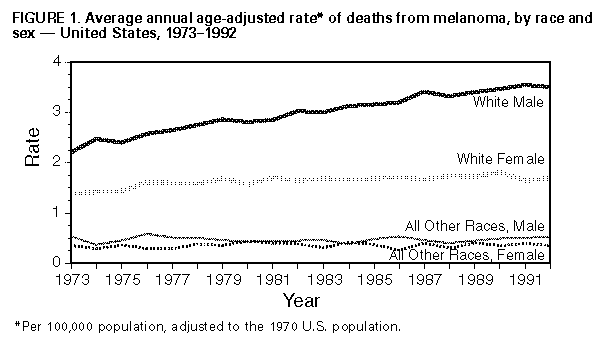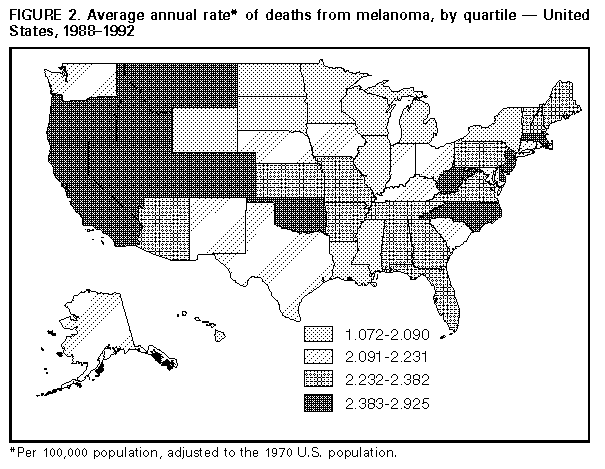 |
|
|
|
|
|
|
| ||||||||||
|
|
|
|
|
|
|
||||
| ||||||||||
|
|
|
|
|
Persons using assistive technology might not be able to fully access information in this file. For assistance, please send e-mail to: mmwrq@cdc.gov. Type 508 Accommodation and the title of the report in the subject line of e-mail. Deaths from Melanoma -- United States, 1973-1992Approximately three fourths of all skin cancer-associated deaths are caused by melanoma. During 1973-1991, the incidence of melanoma increased approximately 4% each year (1). In addition, the incidence of melanoma is increasing faster than that of any other cancer (2). To characterize the distribution of deaths from melanoma in the United States, CDC analyzed national mortality data for 1973 through 1992. This report summarizes the results of that analysis. Decedents for whom the underlying cause of death was melanoma (International Classification of Diseases, Adapted, Ninth Revision, codes 172.0-172.9) were identified from public-use, mortality data tapes from 1973 through 1992 (3). The denominators for rate calculations were derived from U.S. census population estimates (4,5). Rates were directly standardized to the age distribution of the 1970 U.S. population and were analyzed by state, age group, sex, year, and race. To increase the precision of the rates presented, race was characterized as white and all other races because approximately 98% of deaths from melanoma occurred among whites. From 1973 through 1992, the overall percentage increase in the rate of deaths from melanoma (34.1%) was the third highest of all cancers; for males, the percentage increase for melanoma (47.9%) was the highest for all cancers (6). During the same period, the increase in the rate of deaths from melanoma was greater for white males than for other racial and sex groups Figure_1. In 1992, the rate of deaths from melanoma was 5.9 times higher for whites than for all other races (2.5 and 0.4 per 100,000 population, respectively), and 2.1 times higher for males than females (3.1 and 1.5, respectively). To increase statistical precision, the rate of deaths from melanoma by state was aggregated for 1988-1992. In every state, the rate of deaths from melanoma was substantially higher for whites than for persons of all other races. For whites, the age-adjusted death rate by state ranged from 2.2 to 5.0 per 100,000 population for males and 0.8 to 2.3 for females Table_1. Most states that are in the two highest death rate quartiles are not in the lower U.S. latitudes where sun exposure is generally more intense Figure_2. During 1973-1975 and 1990-1992, death rates were highest for white men aged greater than or equal to 50 years Figure_3. The death rate increased more with age for males than for females during 1990-1992. Reported by: Div of Cancer Prevention and Control, National Center for Chronic Disease Prevention and Health Promotion, CDC. Editorial NoteEditorial Note: The findings in this report indicate that the rate of deaths from melanoma was higher for whites than persons of all other races -- a finding consistent with the more common occurrence of melanoma among persons with lightly pigmented skin (2) and an incidence among whites that is more than 10 times higher than that for blacks (1). Based on estimates by the American Cancer Society, during 1995 an estimated 34,100 new cases of melanoma will be diagnosed and 7200 deaths will be caused by melanoma (1). The likelihood of survival of melanoma is substantially greater if the disease is detected early and treated (2). Early detection of thin lesions is associated with improved prognosis and treatment outcome than is detection of thicker, later stage tumors (2). Risk factors (2,7,8) for melanoma related to ultraviolet radiation exposure include a history of sunburn or sun sensitivity, a tendency to freckle, the presence of lightly pigmented skin, blue eyes, and blond or red hair. Other risk factors include a family or personal history of melanoma and the presence of a large number of moles or any atypical moles. Sources for exposure to ultraviolet radiation include sunlight and artificial light (e.g., tanning booths), both of which can cause acute sunburn. The increased risk among persons who sustain intermittent, acute sunburn at an early age (i.e., less than 18 years) underscores the need for initiating prevention measures early in childhood (9). Adults, particularly older men in whom rates of deaths from melanoma are highest, should be encouraged to perform periodic skin self-examination or be examined by a family member (2) to monitor location, size, and color of a pigmented lesion or mole. The "ABCD approach" can be used to assess pigmented lesions and represents mole asymmetry ("A"), border irregularity ("B"), nonuniform color (i.e., pigmentation) ("C"), and diameter greater than 6 mm ("D") (1,2,8). Recommendations for preventing melanoma should emphasize reduction of direct exposure to the sun when sunburn is most likely to occur, especially from 10 a.m. to 3 p.m. Specific measures include wearing a broad-brimmed hat and clothes that protect sun-exposed areas, seeking shade when outdoors, using a sunscreen of sun protection factor greater than or equal to 15 that provides protection against ultraviolet radiation A and ultraviolet radiation B, and referring to the daily Ultraviolet Index * rating provided by the National Weather Service and others when planning outdoor activities. In 1994, CDC implemented a program to assist in achievement of the national health objectives for the year 2000 for preventing skin cancer (10). Elements of the CDC program include funding support for state health departments to develop and implement prevention projects aimed at parents and caregivers of young children; enhancing prevention messages for the public; initiating the development of school health curriculum guidelines; enhancing Ultraviolet Index public health messages; and developing a public and professional education plan for skin cancer prevention. May is Melanoma/Skin Cancer Detection and Prevention Month. Additional information is available from the American Academy of Dermatology, 930 North Meacham Road, Schaumburg, IL 60173-4965. References
* The Ultraviolet Index, provided by the National Weather Service, is broadcast by television and print media in 58 U.S. cities and provides information on the intensity of the sun's rays during the solar noon hour. The index ranges from 0 to 10+ with greater than or equal to 10 indicating the most intense sunlight. Figure_1  Return to top. Table_1 Note: To print large tables and graphs users may have to change their printer settings to landscape and use a small font size.
TABLE 1. Number and rate * deaths from melanoma +, by state, race, and sex
-- United States, 1988-1992
===============================================================================
Rate
--------------------------------------------------
All All White White
State No. Total white other races & males females
-------------------------------------------------------------------------------
Alabama 538 2.3 2.8 0.4 3.9 1.9
Alaska 39 2.1 2.5 @ 3.2 1.7
Arizona 488 2.3 2.5 0.5 3.4 1.6
Arkansas 325 2.2 2.5 0.7 3.3 1.8
California 3,796 2.5 2.9 0.4 4.0 2.0
Colorado 444 2.6 2.7 @ 3.6 2.0
Connecticut 436 2.2 2.3 0.5 2.9 1.9
Delaware 108 2.9 3.4 @ 5.0 2.2
District of Columbia 38 1.1 2.4 0.4 4.3 0.8
Florida 2,210 2.4 2.6 0.4 3.9 1.6
Georgia 731 2.2 2.7 0.6 3.8 1.9
Hawaii 71 1.2 3.1 0.5 4.6 1.8
Idaho 133 2.4 2.4 @ 3.3 1.7
Illinois 1,241 1.9 2.1 0.3 2.9 1.5
Indiana 662 2.1 2.2 0.3 3.1 1.5
Iowa 385 2.1 2.2 @ 2.9 1.6
Kansas 356 2.4 2.5 @ 3.5 1.7
Kentucky 452 2.1 2.3 0.4 3.1 1.5
Louisiana 378 1.7 2.2 0.3 3.1 1.5
Maine 166 2.2 2.3 @ 3.1 1.6
Maryland 565 2.3 2.7 0.4 3.8 1.9
Massachusetts 935 2.6 2.8 @ 3.7 2.1
Michigan 902 1.8 2.0 0.3 2.8 1.3
Minnesota 493 2.0 2.1 0.9 2.6 1.6
Mississippi 269 1.8 2.4 0.5 3.6 1.5
Missouri 730 2.4 2.6 0.3 3.5 1.9
Montana 115 2.4 2.5 @ 3.0 2.0
Nebraska 212 2.2 2.3 @ 3.0 1.7
Nevada 161 2.5 2.6 @ 3.3 2.0
New Hampshire 143 2.3 2.3 @ 3.5 1.5
New Jersey 1,134 2.4 2.7 0.4 3.9 1.8
New Mexico 174 2.2 2.3 @ 2.9 1.8
New York 2,169 2.0 2.3 0.4 3.3 1.6
North Carolina 956 2.5 3.1 0.4 4.1 2.3
North Dakota 65 1.5 1.5 @ 2.2 1.0
Ohio 1,321 2.1 2.3 0.5 3.2 1.5
Oklahoma 483 2.6 2.9 0.3 3.9 2.1
Oregon 425 2.5 2.6 @ 3.4 1.9
Pennsylvania 1,735 2.2 2.4 0.4 3.4 1.7
Rhode Island 138 2.1 2.2 @ 3.3 1.4
Suth Carolina 394 2.1 2.7 0.2 4.1 1.7
South Dakota 85 2.0 2.1 @ 2.8 1.5
Tennessee 662 2.3 2.6 0.5 3.6 1.8
Texas 1,806 2.1 2.3 0.5 3.3 1.6
Utah 213 2.9 3.0 @ 4.0 2.0
Vermont 72 2.4 2.4 @ 3.7 1.3
Virginia 738 2.2 2.6 0.5 3.5 1.9
Washington 598 2.2 2.3 0.3 3.2 1.7
West Virginia 292 2.5 2.6 @ 3.5 1.9
Wisconsin 549 1.9 2.0 @ 2.7 1.4
Wyoming 45 1.9 1.9 @ 2.6 1.3
Total 31,579 2.2 2.5 0.4 3.4 1.7
-------------------------------------------------------------------------------
* Per 100,000 population, adjusted to the 1970 U.S. population.
+ International Classification of Diseases, Adapted, Ninth Revision, codes
172.0-172.9
& Blacks and other races were combined for this analysis because of their small
number of deaths from melanoma and the small population of these groups in
some states.
@ Fewer than 100,000 persons in denominator or fewer than five deaths.
===============================================================================
Return to top. Figure_2  Return to top. Figure_3  Return to top. Disclaimer All MMWR HTML versions of articles are electronic conversions from ASCII text into HTML. This conversion may have resulted in character translation or format errors in the HTML version. Users should not rely on this HTML document, but are referred to the electronic PDF version and/or the original MMWR paper copy for the official text, figures, and tables. An original paper copy of this issue can be obtained from the Superintendent of Documents, U.S. Government Printing Office (GPO), Washington, DC 20402-9371; telephone: (202) 512-1800. Contact GPO for current prices. **Questions or messages regarding errors in formatting should be addressed to mmwrq@cdc.gov.Page converted: 09/19/98 |
|||||||||
This page last reviewed 5/2/01
|